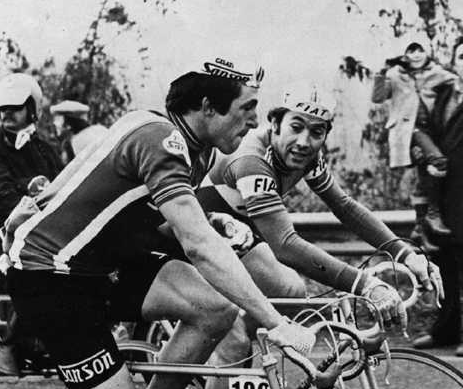At 4 p.m. on Saturday, 19 March 1977, a large crowd at the finish line on the Via Roma in San Remo watched in amazement how the little-known Dutchman Jan Raas stole the day's headlines. Raas had already put in some strong performances earlier that year, but the fact that he won several stages at Paris-Nice and La Méditerranéenne, as well as finishing second in Het Volk, was not mentioned in the Italian newspapers. Moreover, his palmares also left him far behind the favourites of that time.
 Jan Raas at the finish at Milan-San Remo in 1977
Jan Raas at the finish at Milan-San Remo in 1977
A great year for the Dutch, but the Italians could not celebrate. At the race, which they organised themselves, not a single Italian was able to finish in the top. After Raas there were four Belgians with Roger De Vlaeminck, Wilfried Wesemael, Rik Van Linden and Freddy Maertens. The first Italian, Pierino Gavazzi, was sixth.
In the years before Jan Raas rode for the Ti-Raleigh team, but he felt he didn't get enough opportunities here. That's why he switched to the Frisol cycling team in 1977, where he could spread his wings and had more freedom and chances to win.
During the edition of '76 he already had the chance to practice and in 1977 he was well prepared at the starting line. Whenever he could, he watched fragments from the previous editions, with extra attention for the finishes. From this he learned that Eddy Merckx, who won Milan-San Remo seven times, used the Poggio for each of these victories. This is the last climb before the finish of this cycling classic.
The night before the start his sports director, Florent van Vaerenberghe, asked if he was ready to go for the win. Raas was willing to try, so the entire team decided to help him. Even Luis Ocaña wanted to ride for him, because he realised he would not be able to win and he might need the help of Raas in the future.
Still, at Milan-San Remo it's always difficult to estimate who could win, as the race has very few difficult sections. There is the Passo del Turchino and the three Capi (short, but tough climbs): the Capo Mele, Cervo and Berta. Apart from that, the course is mostly on flat asphalt, which makes it an ideal race for strong sprinters on the road. It is a very fast race, which enjoys a lot of prestige, comparable to Paris-Roubaix.
The course of the race
That year, there were no conflicts and the race went quite smoothly. However, there were some quarrels between the Belgians, which reduced their performance. The Italians also made a mistake by waiting for one of the big Belgians to make a decisive move. The French fell through completely, with only three riders able to finish in the top 80: with a 13th place for Guy Sibille, 43rd for Patrick Béon and 63rd for André Mollet, who was even riding for a Belgian team at the time.
 Francesco Moser and Eddy Merckx too busy talking
Francesco Moser and Eddy Merckx too busy talking
However, the race also got off to a difficult start for Jan Raas. He crashed on the Passo del Turchino, breaking his wheel. He had to wait for a new wheel, but his team car was stuck in traffic. Therefore Raas' teammate Wilfried Waesemael gave up his wheel. It took Raas 32 kilometres of hard chasing before he got back.
After the second Capi, four riders were able to escape: Cees Priem of the Frisol team (coincidentally also Raas' brother-in-law), Marcello Osler, Giuseppe Perletto, and Roland Salm. Just before the climb on the Poggio, they had a 20-second lead. Jan Raas attacked with the 19-year-old Italian Guiseppe Saronni and caught up with the leading group. Cees Priem suffered a flat tyre and with his team car at the end of the peloton he had no choice but to give up. Raas profited from this and immediately went on the attack, only Guiseppe Perletto could respond, but he was not strong enough to keep up with Raas on the climb, giving him a 20-metre lead when he reached the top.
This was the moment he could really use the lessons he had learned from Eddy Merckx, and so he began an incredible descent towards the crowded streets of San Remo. But it was not over yet, because once he got down there was still three kilometres to go. He gave everything he had, while he could already feel the peloton breathing down his neck. But he made it and took first place! The crowd was stunned. Who was the boy in the tricolour jersey? The Champion of France? Certainly not, it was Dutch champion Jans Raas!
Quite an achievement, as only three Dutchmen have ever won the race, with Arie den Hartog in 1965 and Hennie Kuiper in 1985.
Jan Raas crossing the finish line first at Milan-San Remo in 1977.
--
Apart from one year with the Frisol team, Jan Raas was active for the Dutch TI-Raleigh cycling team between 1975 and 1983. The jerseys, jackets, shorts and outfits of this iconic cycling team are available at our shop.




Are you a big fan of cycling, like us? Then be sure to keep an eye on our blog. We regularly post new stories about cycling facts, notable events and updates of our product range which are definitely worth reading!